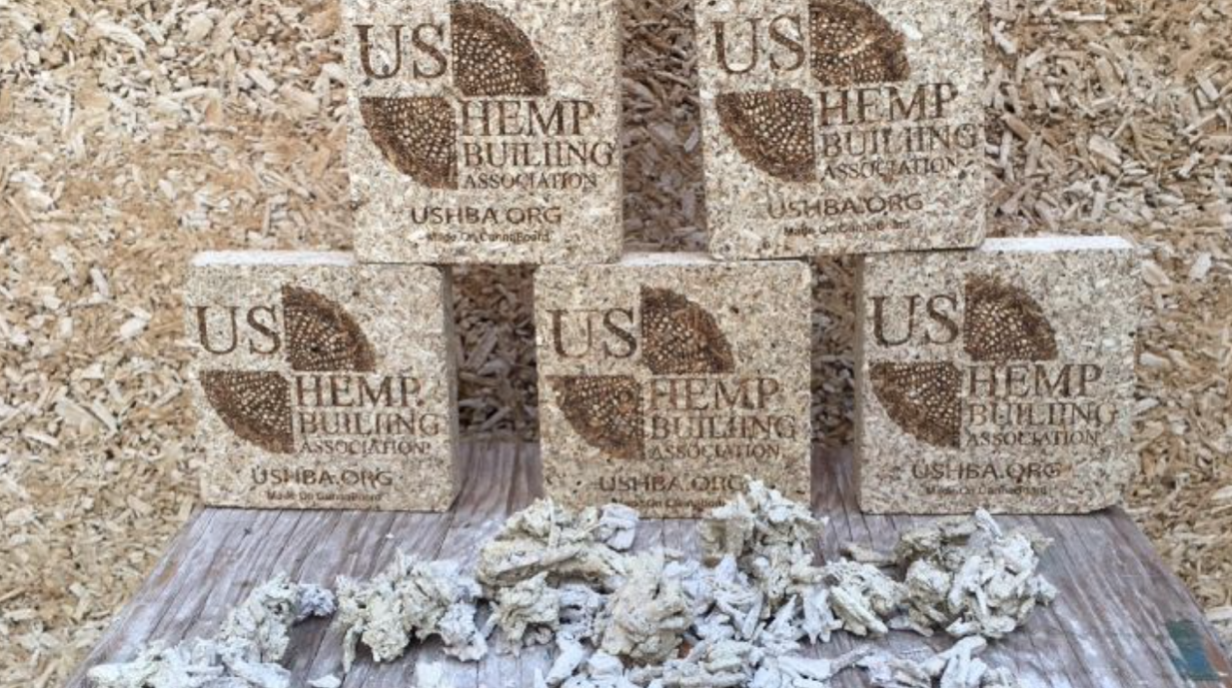Online Conference to Support Hemp in U.S. Building Codes
The U.S. Hemp Building Association will host an online conference and fundraiser Sep. 9-10 to raise money to submit hemp building materials to the International Code Council. Photo courtesy of the U.S. Hemp Building Association
By Jean Lotus
Two dozen speakers and hemp building experts will appear virtually at an upcoming online fundraiser and conference to raise money to certify hemp as an official building material in U.S. building codes.
Hemp Build 2021, the U.S. Hemp Building Association’s online fundraiser and conference takes place Sep. 9-10, 2021. The conference will feature two days of discussions of hemp building, health and environment, architecture, engineering, materials and innovation.
The conference costs $30 and is open to the public. The cost for USHBA members is $10.
“Hemp Build 2021 is looking to educate and start meaningful conversations around hemp building,” Jacob Waddell, the organization’s president, told HempBuildMag.
Subscribe for HempBuild Magazine’s free newsletter
Conference programming will mix up general and specific hemp industry information to engage participants of all knowledge levels, Waddell said. Organizers seek to reach as many conventional building pros and general public members as possible, he added.
The association’s new nonprofit arm, the US Hemp Building Foundation, is raising $100,000 to submit hemp and lime building materials for certification by the International Code Council (ICC) to be included in U.S. building codes for 2022.
The group is following the path blazed in the 1990s by straw bale and straw clay materials natural builders who worked to include natural building materials in U.S. building codes, Waddell said.
“We’re trying to implement a similar strategy to get into the building codes and make hemp and lime known in the codes community, and hopefully take that to the next level,” he added.
There’s an urgency to the project, because the ICC code submission deadline is January, 2022. The submission process won’t reopen again until 2025, Waddell said.
Getting approved by the ICC is just the first step in a process to make hemp building accepted in the United States, as it has been in Europe for 30 years, Waddell said.
The fragmented U.S. building permitting system can shift county by county, but certain jurisdictions will just accept ICC-approved materials, he said. Others, like state building rules for California and Florida, are more challenging, Waddell said.
Click here to go to our FREE online community.
Specifically, the USHBA is working to get hemp+lime insulation, also known as hempcrete, certified through the ASTM (formerly the American Society for Testing Materials) for fireproofing standards, R-value and the test methods used in the R & D protocol.
The goal is to create performance standards but give innovators leeway on how to get there, Waddell said.
“We’re not trying to dictate that, ‘you have to use this lime with this mixture,’” Waddell said. “We want to encourage innovation and growth in the market, because we know it’s coming.”
The ultimate goal is a set of performance guidelines that any building inspector can use to approve a hempcrete-insulated structure.
Another challenge: As U.S. farmers and processors reenter the industrial hemp-growing business after 80 years of prohibition, getting hemp materials up to spec for building materials is still hit-and-miss. Most current hempcrete builders are importing from Europe hemp hurd, the woody inner core of the hemp stalk.
As industrial hemp stalk processing plants come online across North America, U.S. hemp builders need a uniform standard for the best outputs for building materials. Hurd chips for hempcrete must be within certain size specs and must be dust-free.
The new non-profit foundation is also raising money to create stakeholders through workforce development and to create an accurate archive of educational materials for the hemp building industry.
A September project training hemp-lime builders on tribal land in Alabama will experiment with local high-calcium lime, Waddell said. If successful, the project could open up a new source for lime in the U.S.
“We’re trying to create workforces around the country based in underserved communities to make sure that there are more opportunities and demand for starting businesses in the industry to be used in the community,” Waddell said. Meanwhile, educational white papers from experienced hemp builders will help train contractors in hemp building, Waddell said.
Most hempcrete structures currently built in the United States are bespoke dream-home projects that involve special code and permitting variances. Home builders who want to insure and borrow for hempcrete builds have an uphill journey.
But as the construction industry faces the challenges of climate change and looks at limiting greenhouse gasses, renewable natural building materials like hemp can provide a solution.
The industrial hemp plant naturally sequesters about 5 metric tons of CO2 per acre while growing, and further absorbs carbon while in the walls of a hempcrete structure.
Already France has decreed that carbon-sequestering natural materials be used in new government buildings, spurring revolutionary new hempcrete-insulated social housing and a sports center in Paris.
The hemp insulation solution is waiting for the conventional building industry to discover and put into practice, Waddell predicted.
“What I hope is they see these new green possibilities and jump into the market and compete,” he said.
Please Support Our Classified Advertisers
(To find out more about advertising CLICK HERE).
Training and Education
Publications
Hemp Hurd (shivs)/Hemp Fiber/ Hemp Microfiber
Hempcrete installers/Insulation subcontractors
Haven Earth PMA: Bio-Design and Conscious Project Management Consultancy
Hempknowlogy: Home of the Hempjet: America’s first hempcrete spraying system. Manchaca, TX
Lime Binder
Hemp Batt Insulation/Supplies
Green Builders
Hemp Building Engineers
Hemp Genetics
Professional Associations
Evants




